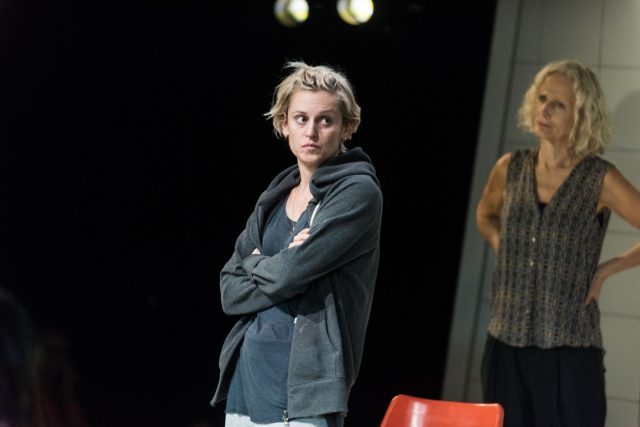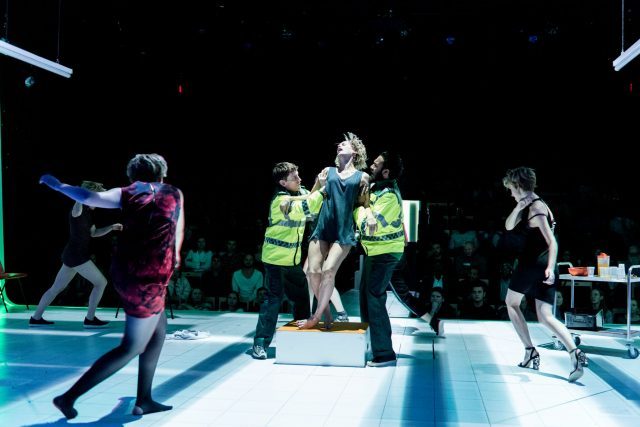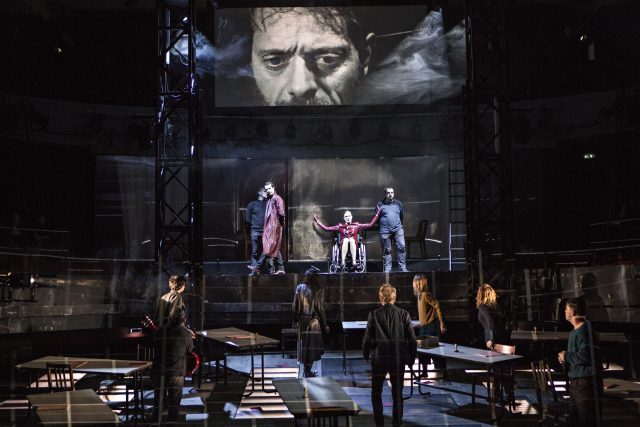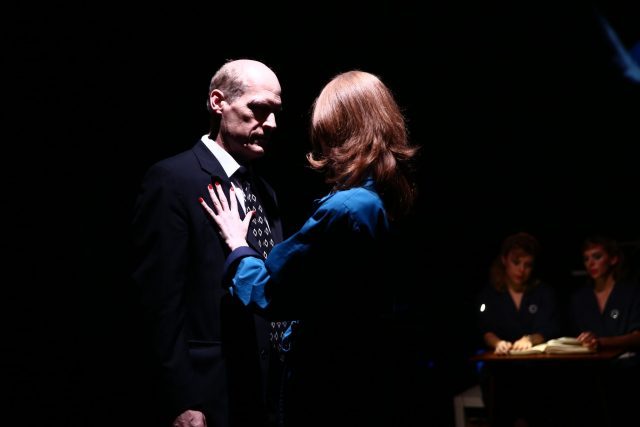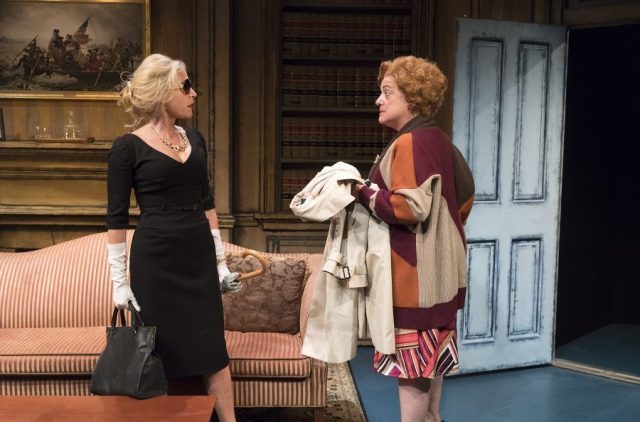
Atalanta Lagana (Sherie Rene Scott) and Mrs. Dragonetti (Mary Testa) are at odds throughout John Patrick Shanley’s The Portuguese Kid (photo by Richard Termine 2017)
Manhattan Theatre Club
MTC at New York City Center – Stage I
Tuesday – Sunday through December 3, $95-$112.50
212-581-1212
theportuguesekid.com
Tony, Oscar, and Pulitzer Prize winner John Patrick Shanley was feeling down in the dumps about the state of the world, so he decided it was time for an old-fashioned Neil Simon-style romantic farce; the result is the hilarious, if bumpy, comedy The Portuguese Kid, which opened last night at Manhattan Theatre Club’s Stage I at City Center. Grieving widow Atalanta Lagana (Sherie Rene Scott) is in the Providence, Rhode Island, home office of her lawyer and childhood friend, Barry Dragonetti (Jason Alexander), reviewing the estate of her recently deceased second husband, Vinny, “a passive aggressive fascist” foot surgeon who voted for Donald J. Trump. ESP-obsessed Atalanta is wearing a sexy black mourning dress and sunglasses, pummeling Barry, who seems to have forced himself into a too-tight, too-blue business suit, with a barrage of brutal one-liners. They’ve been at odds for forty years, ever since ten-year-old Atalanta saved fifteen-year-old Barry when he was mugged by a Portuguese kid, leading to his lifelong horror of anything Portuguese. Atalanta slyly reveals that she’s now seeing Freddy Imbrossi (Pico Alexander), a twenty-nine-year-old carefree would-be poet and real estate agent — and the former passionate lover of Patty (Aimee Carrero), Barry’s hot, sexy, and sensitive young Puerto Rican wife. “What is it? You got a problem with Freddy?” Atalanta says to a disgruntled Barry, who responds, “You got a problem. Freddy Imbrossi? You’d be better off with Lyme disease!” Atalanta then explains that she’s been calling out Barry’s name during sex for years (with both her deceased husbands), which confuses Barry but infuriates his nine-toed mother (Mary Testa), who has been listening in by the door. Barry recuses himself from Atalanta’s case, which fills Mrs. Dragonetti with glee. “I pray to God I never have to violate these eyes with the sight of you again,” she says to the two-time widow.
Clever, witty, and, sometimes a little roughly, the next three scenes in this intermissionless one-act move from Atalanta’s corny but lush bedroom to Barry’s well-appointed backyard, where Patty and Mrs. Dragonetti go at it next, no holds barred, leaving Barry torn between his fiery young wife, who remembers fondly how they met and fell in love, and his hotheaded, nasty mother, who thinks no one is good enough for her baby. The final scene takes place in Atalanta’s garden, where all of the characters gather for a lunch they’ll never forget.

Everyone gathers for a frenetic feast in Manhattan Theatre Club world premiere (photo by Richard Termine 2017)
The Bronx-born Shanley (Doubt, Moonstruck, Prodigal Son,) wrote and directed The Portuguese Kid, making changes to the second and fourth scenes up to the very last minute during previews, and it unfortunately shows; those scenes are more chaotic and unformed than the fabulous first and third scenes, in which the characters are well developed, the actors get to strut their stuff, and the plot thickens in wonderfully acerbic ways. Alexander (Seinfeld, Merrily We Roll Along) excels in a role written with him in mind, all pent-up anger waiting to explode, while three-time Tony nominee Scott (Everyday Rapture, Dirty Rotten Scoundrels) is simply fab as the unpredictable, tough-talking Atalanta (loosely inspired by the virgin huntress in Greek mythology), who regularly admits to having “a darkness.” And there’s little left of the scenery after Drama Desk Award winner Testa (First Daughter Suite, Queen of the Mist) gets through with it; her physical presence is the center of gravity around which her galactic verbal barrages fly. Alexander (Punk Rock, What I Did Last Summer) and Carrero (Young & Hungry, What Rhymes with America) have their moments, but their roles are not as fully fleshed out as Jason Alexander’s and Scott’s; in some ways, the quartet evokes Edward Albee’s Who’s Afraid of Virginia Woolf? The snazzy production features a movable set by John Lee Beatty, fun, colorful costumes by William Ivey Long (Scott’s dresses are too die for), and original music and sound by MTC stalwart Obadiah Eaves. “You underestimate women,” Atalanta tells Barry, who answers, “I’m glad you think so.” In The Portuguese Kid, Shanley most certainly does not underestimate women — or his audience.


